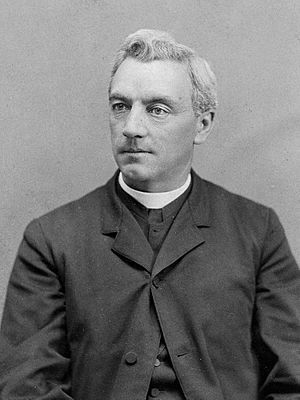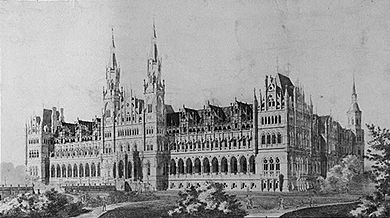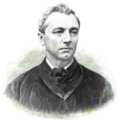Patrick Francis Healy facts for kids
Quick facts for kids
Patrick Francis Healy
|
|||||||
|---|---|---|---|---|---|---|---|

Healy in 1882
|
|||||||
| 29th President of Georgetown University | |||||||
| In office 1873–1882 |
|||||||
| Preceded by | John Early | ||||||
| Succeeded by | James A. Doonan | ||||||
| Personal details | |||||||
| Born | February 27, 1834 Macon, Georgia, U.S. |
||||||
| Died | January 10, 1910 (aged 75) Washington, D.C., U.S. |
||||||
| Resting place | Jesuit Community Cemetery | ||||||
| Relatives | Healy family | ||||||
| Alma mater |
|
||||||
|
|||||||
Patrick Francis Healy (SJ) (February 27, 1834 – January 10, 1910) was an American Catholic priest and Jesuit. He was a very important president of Georgetown University, often called its "second founder." The main building at the university, Healy Hall, is named after him.
Even though Healy thought of himself as White, and most people saw him that way, he was later recognized for his African American heritage. He was the first Black American to become a Jesuit priest, earn a PhD, and lead a mostly White university.
Healy was born in Georgia into a family that had many Catholic leaders. His mother had some African American heritage, and his father was a White Irish immigrant. At that time, laws in Georgia meant that Healy's father legally owned his wife and children. To give them a better life, Healy's father sent Patrick and his siblings North for their education. Patrick continued his studies in Europe, earning his doctorate in philosophy in 1864. He then returned to America to teach philosophy at Georgetown University.
In 1873, Healy was chosen to be the president of Georgetown University. He wanted to make Georgetown a modern university. He helped the sciences grow, improved the School of Medicine, and expanded the Law School. He also oversaw the building of a huge new building, Healy Hall. This project left the university with a lot of debt. In 1882, he moved to live with his brother, James, who was a bishop in Maine. They traveled a lot in Europe. Later, Healy worked as a priest in Rhode Island and New York City before returning to Georgetown, where he passed away.
Contents
Patrick Healy's Early Life
Patrick Francis Healy was born on February 27, 1834, in a log cabin in Macon, Georgia. His father, Michael Morris Healy, came to the United States from Ireland in 1818. He started a cotton farm on land he won in the Georgia Land Lotteries. He became very successful and owned a large amount of land. He also owned 49 people as slaves. One of these was Patrick's mother, Mary Eliza Smith. Michael Healy bought her in 1829. Eliza had some African American heritage, which meant her children also had some.
Laws in Georgia at the time did not allow White and Black people to marry. So, Michael and Eliza had a common-law marriage in 1829. They lived together faithfully for the rest of their lives.
Patrick was the third of 10 children. Eight of them lived to be adults. Three of his sisters became nuns, including Eliza Healy, who became one of the first Black mothers superior of a convent. Two of his brothers became priests. One of them, James Augustine Healy, became the first Black Catholic bishop in the United States. Another brother, Michael, became an important captain in the U.S. Revenue Cutter Service in Alaska.
Because of the laws at the time, Patrick and all his siblings were born into slavery. Michael Healy was not allowed by Georgia law to free his wife or children.
Getting an Education
Laws during this time meant that children born into slavery could not go to school. Michael Healy wanted his children to be free and educated. He sent all of them North. He first found a school in Flushing, New York, that accepted both Black and White students.
Patrick Healy, like three of his brothers, went to the College of the Holy Cross in Massachusetts. He graduated in 1850 when he was 16. He received his degree from Georgetown University, as Holy Cross was not yet able to give out its own degrees.
After graduating, Healy joined the Society of Jesus on September 17, 1850. He was worried that his mixed heritage might stop him from joining, but it did not. With this, he became the first Black American Jesuit.
Healy taught at Saint Joseph's College in Philadelphia and later at the College of the Holy Cross. While teaching, some students who knew his brothers found out about his background and made unkind comments.
In 1858, Healy went to Georgetown University to study philosophy and theology. His Jesuit leaders were impressed by his skills. They sent him to Europe to continue his studies. He studied in Paris and then in Belgium at the Catholic University of Louvain. While there, he became a priest on September 3, 1864. He also learned to speak Latin, French, Italian, and German very well. On July 26, 1865, he earned his PhD in philosophy. This made him the first Black American to earn a PhD.
Understanding His Background
Throughout his life, people wondered about Healy's race. At the time, if a person had any Black ancestor, they were often considered "Black." The Healy brothers saw themselves as White. Patrick Healy looked the most like a White person. His passport even described his skin as "light." Even though he identified as White, some people at Georgetown University knew about his mixed heritage. However, it was not widely known outside of the Jesuit community.
In the mid-1900s, there was new interest in Healy's family history. In the 1950s, a Jesuit scholar wrote a book about their mixed heritage. In the 1960s and 1970s, Georgetown University began to publicly recognize Healy as Black.
Leading Georgetown University
In 1866, Healy returned to Maryland and became the head of the philosophy department at Georgetown University. The university was still recovering from the Civil War. In 1867, he made his final vows as a Jesuit. The next year, he became the prefect of schools.
In 1873, the president of Georgetown, John Early, passed away suddenly. Healy was made the acting leader. The next day, the university's board of directors chose him to be the president of Georgetown University. It took a year for the Jesuit leader in Rome to officially approve him as rector, partly because of concerns about his mixed heritage. On July 31, 1874, he officially became president and rector. This made him the first Black president of a mostly White university in the United States.
Becoming President
As president, Healy wanted to change Georgetown into a modern "university." At the time, a university was a group of schools under one administration. Healy wanted Georgetown to become a place where people could study many different specialized subjects, both religious and non-religious.
More students from the North started coming to Georgetown. Also, the number of Catholic students grew to more than 80%. Healy also started the first official scholarship program. This program paid for one student from each of Washington's Catholic churches to attend. He also changed how student behavior was handled, treating students more like young adults.
Making Changes to Learning
Healy continued to improve the courses offered at Georgetown. By 1879, students could choose between a traditional liberal arts education or a new "commercial and scientific" program. Students in the scientific program earned a Bachelor of Science degree. Healy hired new Jesuit teachers with better academic backgrounds to help with these changes.
He also focused on improving the School of Medicine. He took direct control of the school and changed its faculty. The medical program was made longer, from two to three years, and now included hands-on training. Students also had to pass an entrance exam for the first time.
The Law School also grew a lot during Healy's time. This was partly because the local bar association started requiring new lawyers to have three years of formal legal education.
Building Healy Hall
Healy and a Jesuit leader decided in 1874 that Georgetown needed more buildings. They thought about moving the university, but it was too expensive. So, they decided to improve the existing campus. Healy wanted to build a grand building that would stand out. It would connect two older buildings.
In 1874, Healy hired architects John L. Smithmeyer and Paul J. Pelz to design what would become Healy Hall. The building would be five stories tall with a 200-foot clock tower. It would have classrooms, offices, an auditorium (now Gaston Hall), labs, a library, and student dorms. Construction began in 1877. The project was very expensive and the university had to borrow a lot of money.
To help pay for the building, Healy restarted Georgetown's alumni association in 1880. He also asked a wealthy alumnus, William Wilson Corcoran, to help raise money. Even with these efforts, not enough money was raised. So, from 1878 to 1880, Healy traveled across the country to raise funds. Despite his hard work, he only raised a portion of the money needed.
As construction continued, the costs grew. By 1882, the project had cost a huge amount of money. Because of this difficult financial situation, the university had to let go of staff, including all its non-Jesuit teachers. They also started selling properties they owned.
Later Life and Legacy
Healy had poor health throughout his time as president. In 1881, he went to live with his brother, James, in Maine to get better. After returning to Georgetown in February 1882, his health got worse. He resigned as president on February 16.
After leaving Georgetown, Healy returned to Portland, Maine, to live with his brother. They traveled a lot in Europe, visiting important Catholic places. Healy's health never fully recovered. He later did some pastoral work in Providence, Rhode Island, and New York City. Finally, he moved back to Georgetown University to live out his last years.
Healy passed away at Georgetown on January 10, 1910. His funeral was held in Dahlgren Chapel. He was buried in the Jesuit Community Cemetery on the university's campus. By the time he died, people often called Healy the "second founder" of Georgetown. This was because he led the university through a time of amazing growth.
In 1969, the Georgetown University Alumni Association created the Patrick Healy Award. This award is given each year to someone who is not a Georgetown graduate but has helped the university and supported its values. In 1975, Patrick F. Healy Middle School opened in East Orange, New Jersey.
Images for kids
See also





